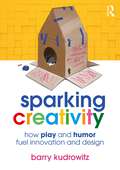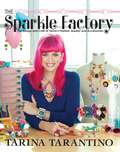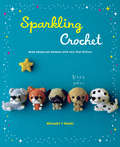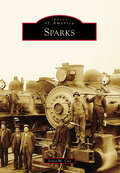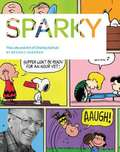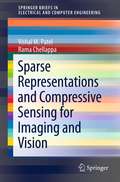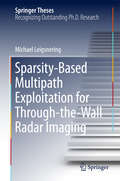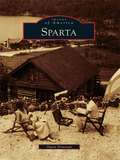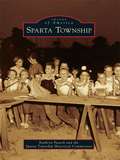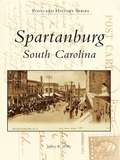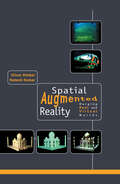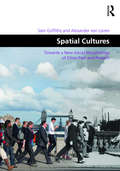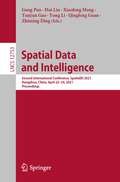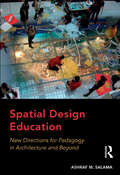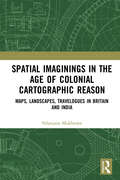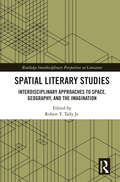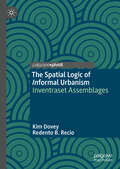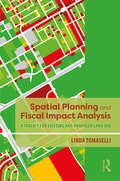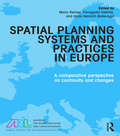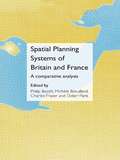- Table View
- List View
The SparkFun Guide to Processing
by Derek RunbergProcessing is a free, beginner-friendly programming language designed to help non-programmers create interactive art with code.The SparkFun Guide to Processing, the first in the SparkFun Electronics series, will show you how to craft digital artwork and even combine that artwork with hardware so that it reacts to the world around you. Start with the basics of programming and animation as you draw colorful shapes and make them bounce around the screen. Then move on to a series of hands-on, step-by-step projects that will show you how to:–Make detailed pixel art and scale it to epic proportions–Write a maze game and build a MaKey MaKey controller with fruit buttons–Play, record, and sample audio to create your own soundboard–Fetch weather data from the Web and build a custom weather dashboard–Create visualizations that change based on sound, light, and temperature readingsWith a little imagination and Processing as your paintbrush, you’ll be on your way to coding your own gallery of digital art in no time! Put on your artist’s hat, and begin your DIY journey by learning some basic programming and making your first masterpiece with The SparkFun Guide to Processing.The code in this book is compatible with Processing 2 and Processing 3.
Sparking Creativity: How Play and Humor Fuel Innovation and Design
by Barry KudrowitzBlending popular culture and design theory, framed by a decade of scholarly research, this book highlights how play and humor fuel innovation. Now, more than ever, we are in need of creative solutions to global problems, but creative skills and abilities decline over time without intervention and practice. Sparking Creativity provides empirically supported methods for embracing the often-trivialized domains of play and humor to increase our creativity. It shows that topical examples, such as Seinfeld's humor, the Apples to Apples board game, and the Adventure Time cartoon series, are more closely related to innovation than you might first think. The book is organized into five main parts, each containing short, engaging subsections and informative, playful, and colorful illustrations to demonstrate concepts. Written in a humorous and accessible style, this book is aimed toward creative-minded entrepreneurs, designers, engineers, industry leaders, parents, educators, and students. It encourages a playful approach throughout a design process to produce truly innovative solutions.
The Sparkle Factory: The Design and Craft of Tarina's Fashion Jewelry and Accessories
by Tarina TarantinoTarina Tarantino's love affair with fashion jewelry and accessories began when she was just a little girl. Tarina now owns and operates her famous global jewelry, accessories, and cosmetics brand, TARINA TARANTINO, out of her international headquarters in downtown Los Angeles, The Sparkle Factory. In her first book, Tarina invites you into her world to learn how to make and wear beautiful and inspirational fashion jewelry. Fashionistas, aspiring jewelry designers, and DIY lovers will learn how to make 20 of Tarina's most essential pieces including statement earrings, cocktail rings, hair jewelry, stretch cuff bracelets, embellished spectacles, and more. Fans of Tarina will also learn about her brand history, getting inspired, creating themes and stories, sourcing materials, essential tools and techniques, how to wear and style your jewelry wardrobe, and more. The text is complemented by tips and hundreds of full-color photos throughout.
Sparkling Crochet: Make Amigurumi Animals with Yarn That Glitters
by Mitsuki HoshiFilled with photographs of adorable sparkly animals and easy-to-follow instructions, Sparkling Crochet is your guide to creating your very own super cute amigurumi characters. Inside, crafters of all levels will learn to make dogs, birds, bugs, bears, and more. Crochet a collection of tiny creatures or turn them into charms, brooches, and other accessories. Created with bright, glittery yarn, these lovable animals can be brought to life in a whole new way.
Sparks (Images of America)
by Joyce M. CoxIn the late 1800s, the area now known as Sparks consisted of ranches and farms. It was not until the early 1900s that Sparks would become the sixth-largest city in Nevada, almost overnight. E.H. Harriman moved the Salt Lake Division of the Southern Pacific Railroad from Wadsworth to swampland four miles east of Reno, and that area would become Sparks. The railroad was the largest and most reliable employer for 54 years, before leaving in 1957. Some railroad employees were transferred and reassigned to jobs outside of Sparks, but many chose to stay. Employment was found in Nevada’s thriving hospitality industry, including John Ascuaga’s Nugget Casino. Sparks became a major distribution center for national companies like S.S. Kresge and Pacific Freeport, and many manufacturing companies opened after Nevada passed the right-to-work law in 1951. Sparks is now the fifth-largest city in Nevada.
Sparky
by Beverly GhermanAs the artist behind the beloved Peanuts comic strip for more than 50 years, Charles Schulz--arguably the most famous cartoonist in the world--created a colorful cast of characters that continues to bring humor and comfort to millions of readers. In this distinctively designed yet highly accessible book, renowned children's biographer Beverly Gherman traces both the life events that shaped Schulz's art and the various ways in which art influenced his life in return. Acclaimed by artists ranging from Andrew Wyeth to Mo Willems, the artistic elements of Schulz's work are brought to life in a colorful layout and thoroughly explored in an enchanting text that will draw in even the most reluctant readers.
Sparrow: A Novel
by Mary Cecilia JacksonIn the tradition of Laurie Halse Anderson’s Speak, Mary Cecilia Jackson's devastating but hopeful YA debut is about a ballerina who finds the courage to confront the abuse that haunts her past and threatens her future.There are two kinds of people on the planet. Hunters and prey I thought I would be safe after my mother died. I thought I could stop searching for new places to hide. But you can’t escape what you are, what you’ve always been. My name is Savannah Darcy Rose. And I am still prey. Though Savannah Rose—“Sparrow” to her friends and family—is a gifted ballerina, her real talent is keeping secrets. Schooled in silence by her long-dead mother, Sparrow has always believed that her lifelong creed—“I’m not the kind of girl who tells”—will make her just like everyone else: Normal. Happy. Safe.But in the aftermath of a brutal assault by her seemingly perfect boyfriend Tristan, Sparrow must finally find the courage to confront the ghosts of her past, or lose herself forever….At the Publisher's request, this title is being sold without Digital Rights Management Software (DRM) applied.
Sparrow (Arthur A Levine Novel Bks.)
by Sarah MoonThe story of a sensitive, gifted African American girl who tells us with mordant humor what it feels like to spend every day wishing so hard that you could fly away from it allSparrow has always had a difficult time making friends. She would always rather stay home on the weekends with her mother, an affluent IT executive at a Manhattan bank, reading, or watching the birds, than play with other kids. And that's made school a lonely experience for her. It's made LIFE a lonely experience.But when the one teacher who really understood her -- Mrs. Wexler, the school librarian, a woman who let her eat her lunch in the library office rather than hide in a bathroom stall, a woman who shared her passion for novels and knew just the ones she'd love -- is killed in a freak car accident, Sparrow's world unravels and she's found on the roof of her school in an apparent suicide attempt.With the help of an insightful therapist, Sparrow finally reveals the truth of her inner life. And it's here that she discovers an outlet in rock & roll music...
Sparse Representations and Compressive Sensing for Imaging and Vision
by Vishal M. Patel Rama ChellappaCompressed sensing or compressive sensing is a new concept in signal processing where one measures a small number of non-adaptive linear combinations of the signal. These measurements are usually much smaller than the number of samples that define the signal. From these small numbers of measurements, the signal is then reconstructed by non-linear procedure. Compressed sensing has recently emerged as a powerful tool for efficiently processing data in non-traditional ways. In this book, we highlight some of the key mathematical insights underlying sparse representation and compressed sensing and illustrate the role of these theories in classical vision, imaging and biometrics problems.
Sparsity-Based Multipath Exploitation for Through-the-Wall Radar Imaging
by Michael LeigsneringThis thesis reports on sparsity-based multipath exploitation methods for through-the-wall radar imaging. Multipath creates ambiguities in the measurements provoking unwanted ghost targets in the image. This book describes sparse reconstruction methods that are not only suppressing the ghost targets, but using multipath to one’s advantage. With adopting the compressive sensing principle, fewer measurements are required for image reconstruction as compared to conventional techniques. The book describes the development of a comprehensive signal model and some associated reconstruction methods that can deal with many relevant scenarios, such as clutter from building structures, secondary reflections from interior walls, as well as stationary and moving targets, in urban radar imaging. The described methods are evaluated here using simulated as well as measured data from semi-controlled laboratory experiments.
Sparta
by Gwen DonovanIncorporated in 1845, Sparta was once a Colonial farming village comprised of stone mills, general stores, and one-room schoolhouses. Summer visitors from surrounding metropolitan areas were drawn to Sparta in the late 1800s for the fresh mountain air. During that time, Thomas Edison came to Sparta to extract iron ore at his massive Edison village manufacturing plant on Sparta Mountain. The 1920s saw the development of Lake Mohawk, permanently changing the landscape of the township as the windswept Brogden Meadow was transformed into a sparkling 3-mile-long lake, which attracted hundreds of part-time residents. While Sparta is no longer a farming community, mining town, or seasonal vacation destination, today's residents take great pride in its small-town appeal and rich, colorful past.
Sparta Township
by Sparta Historical Commission Kathryn PaaschKnown for small-town charm and a beautiful countryside, the area known as Sparta Township was first settled in 1844, and over the next two years it would become home to those pursuing dreams in the logging industry. Rich in a variety of forests, and with the Rogue River and Nash Creek running through it, Sparta first developed saw and flour mills. In the late 1800s, the "Ridge" would develop along the western edge of town, where the land was prime for growing a variety of fruits. When the Pere Marquette Railroad passed through town, it brought opportunity for thriving industry, including the Welch Folding Bed Company, Carnation Creamery, and Sparta Foundry. Spartans enjoyed community picnics, apple smorgasbords, and The Lady of the Lake cruise ship that famously sank to the bottom of Camp Lake. A sense of close-knit community thrives in the area today.
Spartanburg, South Carolina (Postcard History)
by Jeffrey R. WillisPostcards are an important element of understanding our past, for they provide future generations a rare glimpse into a world that many times has disappeared under the aegis of expansion and progress. This book, containing over 200 vintage postcards, allows readers to see one of the South's most historic cities as it looked in the earlier part of the twentieth century--a time when the city was experiencing unparalleled growth. Spartanburg, South Carolina contains scenes of early textile mills, postcards from the early military training camp at Camp Wadsworth, and images of the rapid development of downtown, showcasing Morgan Square, Midtown, Magnolia Street, and Church Street.
Spatial Agency: Other Ways of Doing Architecture
by Nishat Awan Tatjana Schneider Jeremy TillThis book offers the first comprehensive overview of alternative approaches to architectural practice. At a time when many commentators are noting that alternative and richer approaches to architectural practice are required if the profession is to flourish, this book provides multiple examples from across the globe of how this has been achieved and how it might be achieved in the future. Particularly pertinent in the current economic climate, this book offers the reader new approaches to architectural practice in a changing world. It makes essential reading for any architect, aspiring or practicing.
Spatial Augmented Reality: Merging Real and Virtual Worlds
by Oliver Bimber Ramesh RaskarLike virtual reality, augmented reality is becoming an emerging platform in new application areas for museums, edutainment, home entertainment, research, industry, and the art communities using novel approaches which have taken augmented reality beyond traditional eye-worn or hand-held displays. In this book, the authors discuss spatial augmented r
Spatial Cultures: Towards a New Social Morphology of Cities Past and Present (Design and the Built Environment)
by Sam Griffiths Alexander Von LünenWhat is the relationship between how cities work and what cities mean? Spatial Cultures: Towards a New Social Morphology of Cities Past and Present announces an innovative research agenda for urban studies in which themes and methods from urban history, social theory and built environment research are brought into dialogue across disciplinary and chronological boundaries. The collection confronts the recurrent epistemological impasse that arises between research focussing on the description of material built environments and that which is concerned primarily with the people who inhabit, govern and write about cities past and present. A reluctance to engage substantively with this issue has been detrimental to scholarly efforts to understand the urban built environment as a meaningful agent of human social experience. Drawing on a wide range of historical and contemporary urban case studies, as well as a selection of theoretical and methodological reflections, the contributions to this volume seek to historically, geographically and architecturally contextualize diverse spatial practices including movement, encounter, play, procession and neighbourhood. The aim is to challenge their tacit treatment as universal categories in much writing on cities and to propose alternative research possibilities with implications as much for urban design thinking as for history and the social sciences.
Spatial Data and Intelligence: Second International Conference, SpatialDI 2021, Hangzhou, China, April 22–24, 2021, Proceedings (Lecture Notes in Computer Science #12753)
by Gang Pan Hui Lin Xiaofeng Meng Yunjun Gao Yong Li Qingfeng Guan Zhiming DingThis book constitutes the proceedings of the Second International Conference on Spatial Data and Intelligence, SpatialDI 2021, which was held during April 22-24, 2021 in Hangzhou, China.The 14 full papers and 7 short papers presented in this volume were carefully reviewed and selected from 72 submissions. They are organized in the topical sections named: traffic management, data science, and city analysis.
Spatial Design Education: New Directions for Pedagogy in Architecture and Beyond
by Ashraf M. SalamaDesign education in architecture and allied disciplines is the cornerstone of design professions that contribute to shaping the built environment of the future. In this book, design education is dealt with as a paradigm whose evolutionary processes, underpinning theories, contents, methods, tools, are questioned and critically examined. It features a comprehensive discussion on design education with a focus on the design studio as the backbone of that education and the main forum for creative exploration and interaction, and for knowledge acquisition, assimilation, and reproduction. Through international and regional surveys, the striking qualities of design pedagogy, contemporary professional challenges and the associated sociocultural and environmental needs are identified. Building on twenty-five years of research and explorations into design pedagogy in architecture and urban design, this book authoritatively offers a critical analysis of a continuously evolving profession, its associated societal processes and the way in which design education reacts to their demands. Matters that pertain to traditional pedagogy, its characteristics and the reactions developed against it in the form of pioneering alternative studio teaching practices. Advances in design approaches and methods are debated including critical inquiry, empirical making, process-based learning, and Community Design, Design-Build, and Live Project Studios. Innovative teaching practices in lecture-based and introductory design courses are identified and characterized including inquiry-based, active and experiential learning. These investigations are all interwoven to elucidate a comprehensive understanding of contemporary design education in architecture and allied disciplines. A wide spectrum of teaching approaches and methods is utilized to reveal a theory of a ’trans-critical’ pedagogy that is conceptualized to shape a futuristic thinking about design teaching. Lessons learned from techniques
Spatial Imaginings in the Age of Colonial Cartographic Reason: Maps, Landscapes, Travelogues in Britain and India
by Nilanjana MukherjeeThis volume explores how India as a geographical space was constructed by the British colonial regime in visual and material terms. It demonstrates the instrumentalisation of cultural artefacts such as landscape paintings, travel literature and cartography, as spatial practices overtly carrying scientific truth claims, to materially produce artificial spaces that reinforced power relations. It sheds light on the primary dominance of cartographic reason in the age of European Enlightenment which framed aesthetic and scientific modes of representation and imagination. The author cross-examines this imperial gaze as a visual perspective which bore the material inscriptions of a will to assert, possess and control. The distinguishing theme in this study is the production of India as a new geography sourced from Britain's own interaction with its rural outskirts and domination in its fringes. This book: Addresses the concept of "production of space" to study the formulation of a colonial geography which resulted in the birth of a new place, later a nation; Investigates a generative period in the formation of British India c. 1750–1850 as a colonial territory vis-à-vis its representation and reiteration in British maps, landscape paintings and travel writings; Brings Great Britain and British India together on one plane not only in terms of the physical geo-spaces but also in the excavation of critical domains by alluding to critics from both spaces; Seeks to understand the pictorial grammar that legitimised the expansive British imperial cartographic gaze as the dominant narrative which marginalised all other existing local ideas of space and inhabitation. Rethinking colonial constructions of modern India, this volume will be of immense interest to scholars and researchers of modern history, cultural geography, colonial studies, English literature, cultural studies, art, visual studies and area studies.
Spatial Justice and Planning: Reshaping Social Housing Communities in a Changing Society (The Urban Book Series)
by Shaoxu Wang Kai GuDespite the significance of urban justice in planning research and practice, how just societies and cities can be organised and achieved remains contested. Spatial justice provides an integrative and unifying theory concerning place, policies, people and their interplay, but ambiguities about its practical bases have undermined its application in planning. Through creating and substantiating a new conceptual framework comprising a morphological study, policy analysis and embodiment research, this book crystallises the spatiality of (in)justice and (in)justice of spatiality in the context of social housing redevelopment.Like many countries around the world, social housing in Aotearoa New Zealand is an area of contention, especially at the building and redevelopment stages. Protecting community character and human rights has been used by social housing tenants to resist changes, but the primary focus on material outcomes neglects broadening access to planning processes. Compact, mixed tenure and sustainable (re)developments are regarded as the just built environment, as they enable equal accessibility to all. But there are contradictions between the planned spatiality of justice and individuals’ socialised sensory space. Reconciliation of morphological differentiations in built forms and social cohesion remains a challenging task. This book focuses on the re-examination, integration and transferability of spatial justice. It makes a new contribution to urban justice theory by strengthening spatial justice and planning. Social housing areas are expected to adapt to changing social and economic demands while retaining much-valued established community character. This book also provides practical strategies for tackling complex planning problems in social housing redevelopment.
Spatial Literary Studies: Interdisciplinary Approaches to Space, Geography, and the Imagination (Routledge Interdisciplinary Perspectives on Literature)
by Robert T. Tally Jr.Following the spatial turn in the humanities and social sciences, Spatial Literary Studies: Interdisciplinary Approaches to Space, Geography, and the Imagination offers a wide range of essays that reframe or transform contemporary criticism by focusing attention, in various ways, on the dynamic relations among space, place, and literature. These essays reflect upon the representation of space and place, whether in the real world, in imaginary universes, or in those hybrid zones where fiction meets reality. Working within or alongside related approaches, such as geocriticism, literary geography, and the spatial humanities, these essays examine the relationship between literary spatiality and different genres or media, such as film or television. The contributors to Spatial Literary Studies draw upon diverse critical and theoretical traditions in disclosing, analyzing, and exploring the significance of space, place, and mapping in literature and in the world, thus making new textual geographies and literary cartographies possible.
The Spatial Logic of Informal Urbanism: Inventraset Assemblages
by Kim Dovey Redento B. RecioHighly informalized cities of the global South are often portrayed as chaotic and out of control - this book reveals a spatial logic of informal urbanism that is central to the economic life and livelihoods of such cities. 'Inventraset' is a concept that shows how informal street vending, transport and settlement are fundamentally integrated with each other and the more formal city. Street vending and transport provide crucial forms of employment and mobility, while informal settlement is the key source of affordable and adaptable housing. Informal urbanism is not ideal but it is the way such cities work; it is often hidden or camouflaged within the ideal of a clean, green and modern city to which middle-classes and elites aspire. Through comparative studies, with a focus on Manila and Jakarta, the book maps and analyzes how such cities work through alliances and synergies between vending, transport and settlement - inventraset assemblages are inventive and transgressive, yet settled.
Spatial Planning and Fiscal Impact Analysis: A Toolkit for Existing and Proposed Land Use
by Linda TomaselliThe Spatial Fiscal Impact Analysis Method is an innovative approach to measure fiscal impact and project the future costs of a proposed development, recognizing that all revenues and expenditures are spatially related. The Spatial Method focuses on estimating existing fiscal impacts of detailed land use categories by their location. It takes advantage of readily available data that reflect the flows of revenues and expenditures in a city, using the tools of Geographic Information Systems (GIS). The result is a comprehensive yet transparent database for measuring existing fiscal impacts and projecting the impacts of future development or redevelopment. This book will provide readers with guidance as to how to conduct the Spatial Method in their own cities. The book will provide an overview of the history of fiscal analysis, and demonstrate the advantages of the Spatial Method to other methods, taking the reader step by step through the process, from analyzing city financial reports, determining and developing the factors that are needed to model the flows of revenues and expenditures, and then estimating fiscal impact at the parcel level. The result is a summary of detailed land use categories and neighborhoods that will be invaluable to city planners and public administration officials everywhere.
Spatial Planning Systems and Practices in Europe: A Comparative Perspective on Continuity and Changes
by Mario Reimer Panagiotis Getimis Hans Heinrich BlotevogelIdeal for students and practitioners working in spatial planning, the Europeanization of planning agendas and regional policy in general Spatial Planning Systems and Practices in Europe develops a systematic methodological framework to analyze changes in planning systems throughout Europe. The main aim of the book is to delineate the coexistence of continuity and change and of convergence and divergence with regard to planning practices across Europe. Based on the work of experts on spatial planning from twelve European countries the authors underline the specific and context-dependent variety and disparateness of planning transformation, focusing on the main objectives of the changes, the driving forces behind them and the main phases and turning points, the main agenda setting actors, and the different planning modes and tools reflected in the different "policy and planning styles". Along with a methodological framework the book includes twelve country case studies and the comparative conclusions covering a variety of planning systems of EU member states. According to the four "ideal types" of planning systems identified in the EU Compendium, at least two countries have been selected from each of the four different planning traditions: regional-economic (France, Germany), Urbanism (Greece, Italy), comprehensive/integrated (Denmark ,Finland, Netherlands, Germany), "land use planning" (UK, Czech Republic, Belgium/Flanders), along with two additional case studies focusing on the recent developments in eastern European countries by looking at Poland and in southern Europe looking at Turkey.
Spatial Planning Systems of Britain and France: A Comparative Analysis
by Philip Booth Michèle Breuillard Charles Fraser Didier ParisSpatial Planning Systems of Britain and France brings together a wide selection of comparative essays to highlight the fundamental similarities and differences between the spatial planning in Great Britain and France: two countries that are near neighbours and yet have developed very different modes of planning in terms of their structure, practical application and underlying philosophies. Drawing on the outcomes of the Franco-British Planning Study Group and with a foreword by Vincent Renard of the Ecole Polytechnique in Paris, the book offers a comparative investigation of the basic contexts for planning in both countries, including its administrative, economic, financial and legal implications, and then move on to illustrate themes such as urban policy and transport planning through detailed analysis and case studies. From these investigations the book brings together planning concepts from both a national and European perspective, looking particularly at two current issues: the effects of urban growth on small market towns and the use of Public-Private partnerships to implement development projects. Spatial Planning Systems of Britain and France will prove invaluable to policy makers and practitioners in both countries at a time when national policy is beginning to look towards practice in other countries. The book is published simultaneously in English and French opening up a wider debate between the English-speaking and francophone worlds.

